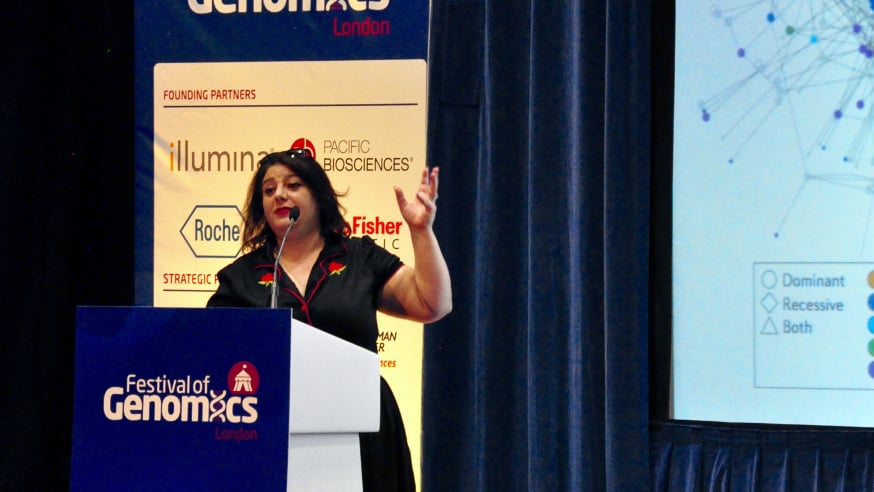
Dr Bissan Al-Lazikani speaking at the Festival of Genomics 2016 (photo: Frontline Genomics 2016)
Technological developments in research and healthcare mean we are now generating vast quantities of clinical data spanning molecular profiling, clinical imaging and more, all at an unprecedented rate.
In fact, the volume of genomic data we’re now acquiring is starting to outstrip even the data generated in disciplines such as astronomy, traditionally seen as enormous - astronomical even!
Last week I went to a fascinating talk focused on the way we can take these enormous volumes of complex genomic data and harness it all to help create exciting new treatments for people with cancer.
Dr Bissan Al-Lazikani, Team Leader in Computational Biology and Chemogenomics here at The Institute of Cancer Research, spoke at London’s first Festival of Genomics, on using genomics to help us reveal the best new targets for cancer drugs.
She explained that there had been many studies sequencing the genomes of cancer patients to find the drivers of their tumours, and that these had tended to throw up a series of ‘usual suspects’ very strongly. But in addition, those studies have generated a cloud of smaller hits which are often genes which people haven’t heard of, for proteins in pathways that they don’t know anything about, but that are nonetheless very important.
Dr Al-Lazikani made a plea to the audience: we must not restrict the scope of our drug discovery by ignoring these more enigmatic results, as we could well be missing many druggable targets. Before throwing away these targets, we need to explore them.
But how do we know which leads to follow and which are likely to be dead ends?
Untapped potential
Current estimates suggest that we only have approved drugs acting on around 5% of the 500 or so cancer-causing proteins. But the good news is that at least 25% of the proteins in the human body have the potential to be druggable, so there are many untapped opportunities.
Dr Al-Lazikani explained that she was working to create computer programmes which use artificial intelligence to look for patterns in the way that druggable cancer proteins behave, and then look for other proteins which behave in a similar way, and could also be targeted by new drugs.
As a simple example, she told us that it is much easier to switch a protein off, rather than finding one that has been inactivated and trying to switch it back on again. By combining simple properties like this, and many more complex ones, the programme can learn and identify the proteins most likely to be effectively targeted with drugs.
And her software doesn’t only look at the properties of individual proteins in isolation, but also how they are interconnected with other proteins in the cell.
I was interested to hear that the statistics method she’s using to analyse networks is the same as Facebook uses to map our network of friends. We can look to see which proteins have the most connections or ‘friends’ and who their ‘friends of friends’ are in order to see how well connected they are.
In this way, Dr Al-Lazikani’s team identified distinctive ‘social’ behaviours of cancer proteins and drug targets than can be used to predict future new drug targets. Dr Al-Lazikani published some of her work on this recently and you can read more about it in on our website.
By bringing all of this information together we can also predict the best combinations of drugs to give. She explained that if there are two proteins which behave in a similar way then blocking them both won’t have a long-lasting impact. To have a greater effect, we need to be blocking those working in different ways.
Big questions
Her key messages sounded positive and as though we are on the cusp of lots of new discoveries. Thanks to the advances in technology, cancer genomics is revealing many potential targets, particularly if we use a data-driven approach to look for them and objectively pick the best targets.
She had a fantastic example of how she had used this technique to identify 46 cancer genes which would make good cancer drug targets but that had been previously overlooked. Her research has now changed that, with several of these proteins now being tackled by academia and industry.
One of the main messages I took away from the event was that the key to answering some of the big questions in cancer research was to analyse the entire complexity of the data as a whole rather than individual data types.
And another key message would be familiar to readers of the ICR blogs – that the most challenging research problems are only going to be solved by researchers from many different disciplines – with different skills and access to different datasets – working together.
comments powered by